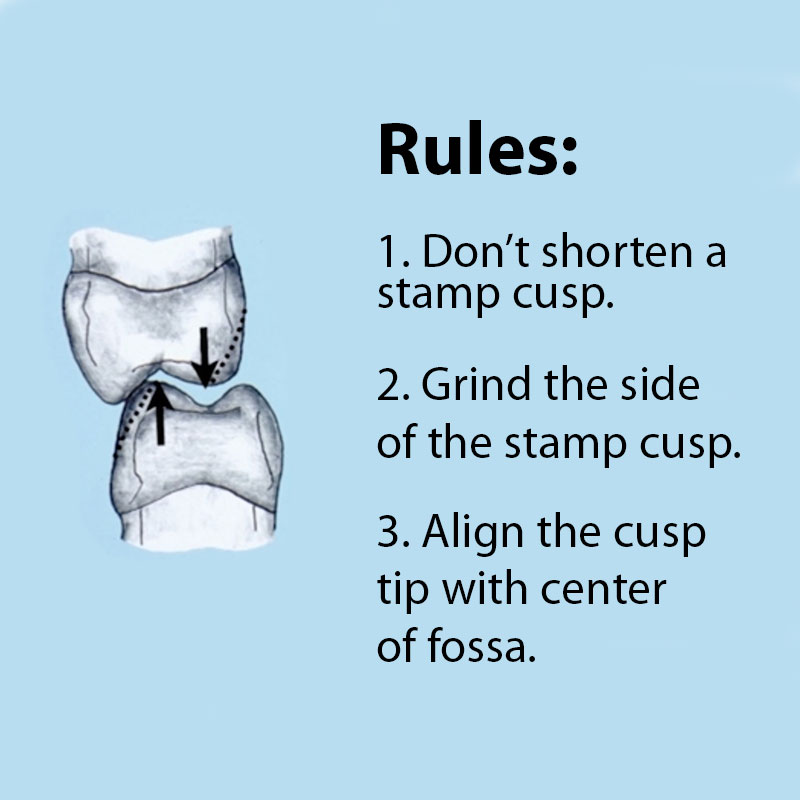Some users may experience temporary issues accessing parts of the site. Thanks for your patience.
- Office Hours Mon - Fri 9:00 am – 4:00 pm EST
Hey everybody. Welcome to Quick Tips. Today I want to talk to you about creating stable, equal intensity stops when we’re looking at occlusion.
We talk about five requirements of occlusal stability, and number one is making sure that when we close our mouth that we have as many teeth as possible, hopefully 14 teeth, hitting 14 teeth simultaneously with equal intensity contact.
 And so when we think about how a jaw closes, we want to make sure that we are aligning the cusp tip into the appropriate fossa or marginal ridge. So when we look at this stable bite, we are visualizing that cusp tip landing on a flat surface. If it’s landing on an incline, it’s going to cause the tooth to shift positions, get loose, move out of the way, or not be optimally stable.
And so when we think about how a jaw closes, we want to make sure that we are aligning the cusp tip into the appropriate fossa or marginal ridge. So when we look at this stable bite, we are visualizing that cusp tip landing on a flat surface. If it’s landing on an incline, it’s going to cause the tooth to shift positions, get loose, move out of the way, or not be optimally stable.
Transcript continued below…
So you look at a reconstruction like this where we have control over everything, we do want stops all the way around. Lower incisors are going to be touching under the singulums hopefully, and then we want those upper lingual cusps landing on a marginal ridge or a central fossae and the lower buckle cusp doing the same thing.
 Do we grind the inside of the fossa or do we start sharpening cusps? The key to remember is to look at the sides of the stamp cusps if the cusp isn’t aligned properly.
Do we grind the inside of the fossa or do we start sharpening cusps? The key to remember is to look at the sides of the stamp cusps if the cusp isn’t aligned properly.
Now a stamp cusp is a cusp that fits into a fossa. It’s a lower buckle cusp or an upper lingual cusp.
That is not what we do when we’re adjusting somebody’s bite, whether it’s restorations that we’ve just placed or the natural dentition. What we’re going to do is grind on the side of the stamp cusp, lower buckle cusp and upper lingual cusp, and align the cusp tip towards the opposite fossa or marginal ridge.
I think if you do that, you’re going to find it unbelievably easy to get the cusp to land in a place that is going to be stable. And it also allows you to do this very, very rapidly.
 So, as we look at our situations that we see again, if you have a pre-op situation where you see that mark on the side of the stamp cusp, do not open fossae up. If you’re opening fossaes up we often are grinding on the incline of a non-functional cusp – upper buckle cusp or lower lingual cusp – which can severely weaken those cusps. Grinding on the side of the stamp cusp is where to go.
So, as we look at our situations that we see again, if you have a pre-op situation where you see that mark on the side of the stamp cusp, do not open fossae up. If you’re opening fossaes up we often are grinding on the incline of a non-functional cusp – upper buckle cusp or lower lingual cusp – which can severely weaken those cusps. Grinding on the side of the stamp cusp is where to go.
So if we, to identify precisely where we want the cusp to land, then use something like a carbide finishing bur – a football shaped carbide finishing bur – and just narrow your cusp.  This is an extremely good example of an ideal occlusion. Very light and precise stops on cusp tips and marginal ridges.
This is an extremely good example of an ideal occlusion. Very light and precise stops on cusp tips and marginal ridges.
So my quick tip today is look at the sides of those stamp cusps. They are the place you should be adjusting. Get them aligned with the opposite central fossa and marginal ridge and I think you’ll have a lot of success.
Good luck with that and we will see you next time on Quick Tips.
ADA CERP is a service of the American Dental Association to assist dental professionals in identifying quality providers of continuing dental education. ADA CERP does not approve or endorse individual courses or instructors, nor does it imply acceptance of credit hours by boards of dentistry.
Concerns or complaints about a CE provider may be directed to the provider or to the Commission for Continuing Education Provider Recognition at ADA.org/CERP.